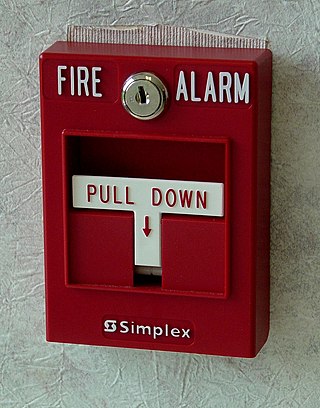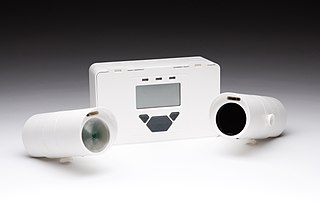Related Research Articles

An alarm device is a mechanism that gives an audible, visual, combination, or other kind of alarm signal to alert someone to a problem or condition that requires urgent attention.

A smoke detector is a device that senses smoke, typically as an indicator of fire. Smoke detectors/Alarms are usually housed in plastic enclosures, typically shaped like a disk about 150 millimetres (6 in) in diameter and 25 millimetres (1 in) thick, but shape and size vary. Smoke can be detected either optically (photoelectric) or by physical process (ionization). Detectors may use one or both sensing methods. Sensitive alarms can be used to detect and deter smoking in banned areas. Smoke detectors in large commercial and industrial buildings are usually connected to a central fire alarm system.

A security alarm is a system designed to detect intrusions, such as unauthorized entry, into a building or other areas, such as a home or school. Security alarms protect against burglary (theft) or property damage, as well as against intruders. Examples include personal systems, neighborhood security alerts, car alarms, and prison alarms.

A fire alarm control panel (FACP), fire alarm control unit (FACU), fire indicator panel (FIP), or simply fire alarm panel is the controlling component of a fire alarm system. The panel receives information from devices designed to detect and report fires, monitors their operational integrity, and provides for automatic control of equipment, and transmission of information necessary to prepare the facility for fire based on a predetermined sequence. The panel may also supply electrical energy to operate any associated initiating device, notification appliance, control, transmitter, or relay. There are four basic types of panels: coded panels, conventional panels, addressable panels, and multiplex systems.
A false alarm, also called a nuisance alarm, is the deceptive or erroneous report of an emergency, causing unnecessary panic and/or bringing resources to a place where they are not needed. False alarms may occur with residential burglary alarms, smoke detectors, industrial alarms, and in signal detection theory. False alarms have the potential to divert emergency responders away from legitimate emergencies, which could ultimately lead to loss of life. In some cases, repeated false alarms in a certain area may cause occupants to develop alarm fatigue and to start ignoring most alarms, knowing that each time it will probably be false. Intentionally falsely activating alarms in businesses and schools can lead to serious disciplinary actions, and criminal penalties such as fines and jail time.

Manual fire alarm activation is the process of triggering a fire alarm through a call point, pull station, or other device. This usually causes the alarm to sound the evacuation signal for the relevant building or zone. Manual fire alarm activation requires human intervention, as distinct from automatic fire alarm activation such as that provided through the use of heat detectors and smoke detectors. It is, however, possible for call points/pull stations to be used in conjunction with automatic detection as part of the overall fire detection and alarm system. Systems in completed buildings tend to be wired in and include a control panel. Wireless activators are common during construction.

A carbon monoxide detector or CO detector is a device that detects the presence of the carbon monoxide (CO) gas to prevent carbon monoxide poisoning. In the late 1990s Underwriters Laboratories changed the definition of a single station CO detector with a sound device to carbon monoxide (CO) alarm. This applies to all CO safety alarms that meet UL 2034 standard; however for passive indicators and system devices that meet UL 2075, UL refers to these as carbon monoxide detectors. Most CO detectors use a sensor with a defined, limited lifespan, and will not work indefinitely.

A motion detector is an electrical device that utilizes a sensor to detect nearby motion. Such a device is often integrated as a component of a system that automatically performs a task or alerts a user of motion in an area. They form a vital component of security, automated lighting control, home control, energy efficiency, and other useful systems.

An aspirating smoke detector (ASD) is a system used in active fire protection, consisting of a central detection unit which draws air through a network of pipes to detect smoke. The sampling chamber is based on a nephelometer that detects the presence of smoke particles suspended in air by detecting the light scattered by them in the chamber. ASDs can typically detect smoke before it is visible to the naked eye.

A heat detector is a fire alarm device designed to respond when the convected thermal energy of a fire increases the temperature of a heat sensitive element. The thermal mass and conductivity of the element regulate the rate flow of heat into the element. All heat detectors have this thermal lag. Heat detectors have two main classifications of operation, "rate-of-rise" and "fixed temperature". The heat detector is used to help in the reduction of property damage.

A fire alarm system is a building system designed to detect, alert occupants, and alert emergency forces of the presence of fire, smoke, carbon monoxide, or other fire-related emergencies. Fire alarm systems are required in most commercial buildings. They may include smoke detectors, heat detectors, and manual fire alarm activation devices. All components of a fire alarm system are connected to a fire alarm control panel. Fire alarm control panels are usually found in an electrical or panel room. Fire alarm systems generally use visual and audio signalization to warn the occupants of the building. Some fire alarm systems may also disable elevators, which are unsafe to use during a fire under most circumstances.
A flame detector is a sensor designed to detect and respond to the presence of a flame or fire, allowing flame detection. Responses to a detected flame depend on the installation, but can include sounding an alarm, deactivating a fuel line, and activating a fire suppression system. When used in applications such as industrial furnaces, their role is to provide confirmation that the furnace is working properly; it can be used to turn off the ignition system though in many cases they take no direct action beyond notifying the operator or control system. A flame detector can often respond faster and more accurately than a smoke or heat detector due to the mechanisms it uses to detect the flame.
The EN 54 Fire detection and fire alarm systems is a series of European standards that includes product standards and application guidelines for fire detection and fire alarm systems as well as voice alarm systems.
Home safety is the awareness of risks and potential dangers in and around a home that may cause bodily harm, injury, or even death to those living there.
Fire detectors sense one or more of the products or phenomena resulting from fire, such as smoke, heat, infrared and/or ultraviolet light radiation, or gas.

Honeywell Gent, formerly Gents' of Leicester, is a British manufacturer of life safety equipment based in Leicester, England. Established by John Thomas Gent, the company is thought to have started in 1872 however it could have been trading as early as the 1860s. The company had a workforce of several hundred at its height.

An optical beam smoke detector is a device that uses a projected beam of light to detect smoke across large areas, typically as an indicator of fire. They are used to detect fires in buildings where standard point smoke detectors would either be uneconomical or restricted for use by the height of the building. Optical beam smoke detectors are often installed in warehouses as a cost-effective means of protecting large open spaces.

Enigma Technologies, Inc., is a data science company headquartered in New York City that specializes in providing data and intelligence about businesses. The company is mainly known for Enigma Public, a now defunct library of public data.
Netatmo is a French company which manufactures smart home devices. Founded in 2011, it has launched a variety of products including various security cameras, personal weather stations, and an internet-connected smoke detector.
Sound recognition is a technology, which is based on both traditional pattern recognition theories and audio signal analysis methods. Sound recognition technologies contain preliminary data processing, feature extraction and classification algorithms. Sound recognition can classify feature vectors. Feature vectors are created as a result of preliminary data processing and linear predictive coding.
References
- ↑ "The innovative project chosen as a finalist in Google's Impact Challenge | World Vision Australia". www.worldvision.com.au. Retrieved 2017-07-31.
- ↑ "A little blue box that might help save thousands of homes in South Africa". Public Radio International. Retrieved 2017-07-31.
- ↑ Nofemele, Lumk A (2017-02-01). "The little blue box that's saving homes and saving lives". Popular Mechanics. Retrieved 2017-07-31– via PressReader.
- 1 2 Eastaugh, Sophie (23 August 2016). "The little blue box that can save lives". CNN. Retrieved 2017-07-31.
- ↑ "A Smart Heat Detector Reduces The Threat Of Cooking Fires Burning Down Shanty Towns". Fast Company. 2014-09-11. Retrieved 2017-07-31.
- ↑ "Lumkani - low cost fire detection system" (PDF). www.rci.uct.ac.za.
- ↑ "AIF announces the 10 nominees for its annual Innovation Prize for Africa Awards" . Retrieved 2017-07-31.
- ↑ "Where there's smoke, there might not be fire, so this device detects heat instead". Digital Trends. 2015-08-04. Retrieved 2017-07-31.
- ↑ "10 African 'tech for good' startups to watch in 2017 - Ventures Africa". Ventures Africa. 2017-04-10. Retrieved 2017-07-31.
- 1 2 "Lumkani Fire Detection". www.globalinnovationexchange.org. Retrieved 2017-07-31.
- ↑ "Fire detection startup Lumkani set to launch across South Africa". Disrupt Africa. 2015-04-22. Retrieved 2017-07-31.
- 1 2 "2015 Finalists". The Tech. 2015-09-01. Retrieved 2017-07-31.
- ↑ "Lumkani — Social Tech Guide". Social Tech Guide. Retrieved 2017-07-31.
- ↑ "Lumkani". Chivas (in Spanish). Retrieved 2017-07-31.